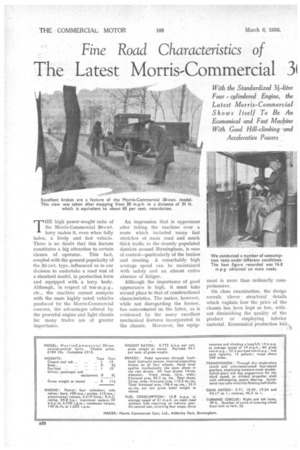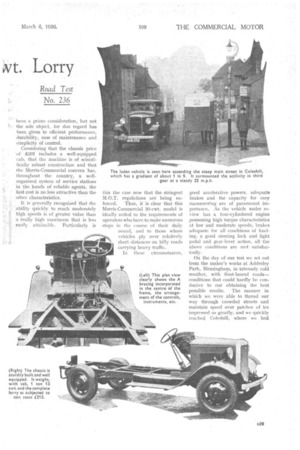Fine Road Characteristics of
Page 38

Page 39

Page 40

If you've noticed an error in this article please click here to report it so we can fix it.
Latest Morris-Commercial 31
xi Lorry
THE high power-weight ratio of the Morris-Commercial 30-cwt. lorry makes it, even when fully laden, a lively and fast vehicle. There is no doubt that this feature constitutes a big attraction to certain classes of operator. This fact, coupled with the general popularity of the 30-cwt. type, influenced us in our decision to undertake a road test of a standard model, in production form and equipped with a lorry body. Although, in respect of ton-m.p.g., etc., the machine cannot compete with the more highly rated vehicles produced by the Morris-Commercial concern, the advantages offered by the powerful engine and light chassis for many trades are of greater importance.
An impression that is uppermost after taking the machine over a route which included many fast stretches of main road and much thick traffic in the densely populated districts around Birmingham, is ease of control—particularly of the brakes and steering. A remarkably high average speed can be maintained with safety and an almost entire absence of fatigue.
Although the importance of good appearance is high, it must take second place to that of constructional characteristics. The maker, however, while not disregarding the former, has concentrated on the latter, as is evidenced by the many excellent mechanical features incorporated in the chassis. Moreover, the equip merit is more than ordinarily com
prehensive.
On close examination, the design reveals clever structural details which explain how the price of the chassis has been kept so low, without diminishing the quality of the product or employing inferior material. Economical production
been a prime consideration, but not
• the sole object, for due regard has been given to efficient performance, durability, ease of maintenance and simplicity of control.
• Considering that the chassis price of £201. includes a well-equipped cab, that the machine is of scientifically robust construction and that the Morris-Commercial concern has, throughout the country, a wellorganized system of service stations in the hands of reliable agents, the first cost is no less attractive than the
other characteristics. • It is generally recognized that the ability quickly to reach moderately high speeds is of greater value than a really high maximum that is less easily attainable. Particularly is this the case now that the stringent M.O.T. regulations are being en forced. Tints, it is clear that this Morris-Commercial 30-cwt. model is ideally suited to the requirements of operators who have to make numerous stops in the course of their daily round, and to those whose vehicles ply over relatively short distances on hilly roads carrying heavy traffic.
In these circumstances,
good accelerative powers, adequate brakes and the capacity, for easy marneuvring are of paramount importance. As the vehicle under review has a four-cylindered engine possessing high torque characteristics at low and moderate speeds; brakes adequate for all conditions of loading, a good steering lock and light pedal and gear-lever action, all. the above conditions are met 'satisfactorily.
On the day of our test we set out from the maker's works at Adderley Park, Birmingham, in intensely cold weather, with fx:ost-bound roads— conditions that could hardly be conducive to our obtaining the best possible results. The manner in which we were able to thread our way through crowded streets and maintain speed over patches •of ice impressed us greatly, and we quickly reached Coleshill, where we had
planned to carry out the hill-climbing test.
From what we had already observed of the performance of the machine, we were not surprised that it made light of this ascent. The incline running through the centre of the town has a gradient of about 1 in 9, which was taken comfortably in third par (1045 to 1) at a steady 22 m.p.h., without any attempt having been made to rush the early slopes. During a subsequent climb, a stop-and-restart test was carried out on the steepest portion of the hill and it was obvious, from the smooth manner in which the engine picked up the load, that the transmission is planned on sound lines and is devoid of backlash.
Proceeding then to a level stretch on the Coventry-Castle Bromwich road, we put the vehicle through the usual acceleration and brake tests; the accompanying graphs reveal the performance clearly enough. In both directions over the same section the acceleration was almost identical, Another notable point concerns the maximum permissible speed, using third gear; as this is as high as 30 m.p.h., the performance in really hilly country should benefit accordingly.
A peculiarity of the braking graph is the manner in which, on an efficiency basis, the hand-brake curve approaches that of the foot brake, despite the fact that the lever applies shoes in only the rear drums, whilst the pedal operates brakes on all four wheels. In the pedal-applied system retardation is limited by the capacity of the rear tyres to maintain a grip of the road, but owing to the icy conditions prevailing at the time of our test it is reasonable to suppose that an even fiercer retardation than that obtained should be possible without locking the wheels. No advantage was obtained in -using hand and foot brakes simultaneously.
We carried out a number of fuelconsumption tests and were somewhat surprised at the similarity of the results, despite considerable dissimi e30 larities of conditions. When averaging 21 m.p.h. over main roads, consumption returns around 16 m.p.g. were the general order; increasing the average speed by 5 m.p.h. had little effect on fuel consumption, the figure recorded being in excess of 15 m.p.g. On one short run, which included four stops and three reverses, besides the negotiation of the hill in Coleshill, the recorded figure was 14 m.p.g.
As this 30-cwt. lorry comes within the class likely to be used for general delivery services, we endeavoured to reproduce conditions under which the vehicle may have to operate. Accordingly, a special test was instituted whereby the machine was stopped and restarted every half mile. On half a gallon of fuel 7.5 miles were traversed, making 14 voluntary stops. At every stop the vehicle was brought to rest, 'brakes were applied and the engine switched off. Despite such conditions, the 7.5 miles were covered in 21 minutes, giving an average speed of slightly' more than 21 m.p.h. This and the consumption rate of 15 m.p.g. constitute a very good performance.
Although not lacking in robustness, there is no feeling of heaviness about the control of the vehicle. For ' one thing, the Lockheed brakes have'; adequate retarding powers with only
a moderate pedal pressure, and care has been taken to make the clutch operation as light as possible. A long lever helps to make gear changing easy, whilst the steering, despite the fact that it is moderately direct in action, is, nevertheless, also quite light. Even when manoeuvring the lorry at low road speeds, there is no need for the driver to exert himself unduly in order to bring the front wheels from one lock to the other, whilst on the open road the action of steering is comparable with that of a private car.
Good riding qualities are an asset to any chassis, and we are able to record that we have nothing but praise for the manner in which this Morris-Commercial holds the road and takes badly pot-holed surfaces at high speed.




















































































